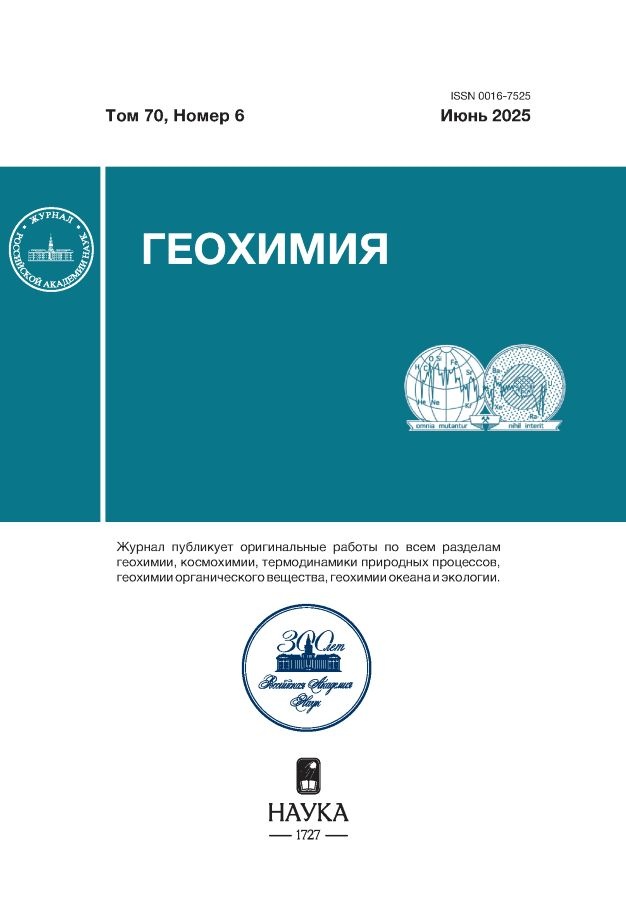Volume 70, Nº 6 (2025)
- Ano: 2025
- Artigos: 3
- URL: https://journals.eco-vector.com/0016-7525/issue/view/13789
Edição completa
Articles
Neon as a criterion for noble gas distribution between gas accumulations and edgewater
Resumo
The dependence of the isotopic composition of Ne on the partial pressure of Ne, N2 and the ratio of N2 /Ne is analyzed for the first time. The scale of the influence of groundwater on the content and isotopic composition of noble gases in CO2, N2 and CH4 gas reservoirs is also estimated. It is shown that the partial pressure of Ne in gas accumulations increases in the range: CO2 – CH4 – N2. The CO2 gas accumulations are characterized by the mantle isotopic composition of neon, and the N2 gas accumulations are dominated by a mixture of atmospheric and crustal neon (20Ne/22Ne is in the range of 8.9–10.2; 21Ne/22Ne 0.040–0.083). The initial concentrations and isotopic composition of Ne and, obviously, other noble gases depend on the conditions of formation of the gas phase that enters the reservoir. Subsequently, the partial pressure of Ne in the CO2 and CH4 gas accumulations increases, and the partial pressure of Ne in the N2 gas accumulations decreases, presumably due to gas exchange with groundwater. A model of gas exchange between gas accumulations and groundwater is proposed, which makes it possible to estimate the distribution of noble gases between them: (1) CO2 enters reservoirs with negligibly low (~0.008 Pa) partial pressures of mantle Ne. Therefore, the admixture of Ne from groundwater can reach 90 % in them; (2) On the contrary, N2 deposits have an atmospheric isotopic composition of Ne with the addition of a nucleogenic (crustal) component and a partial pressure higher than in the atmosphere. The ancient Cl–Ca brines at the reservoir pressure below 300 bar are the most likely source of this N2 gas phase; (3) The isotopic composition of Ne in CH4 accumulations corresponds to the microbial methane which is formed in near–surface conditions (the environment enriched in atmospheric gases), while thermogenic methane is formed at greater depths. Probably, major part of the Ne and N2 in the thermogenic CH4 accumulations are the result of the gas exchange with Cl–Ca brines. In general, the isotopic composition of Ne in CH4 accumulations reflect the mixing of microbial and thermogenic CH4 on migration routes to the surface.
 427-457
427-457


Carbon behavior and formation of water chemical composition in the drainage system of the drained eutrophic peatland
Resumo
Peatlands are recognized as one of the most critical ecosystems for long-term carbon sequestration, although they cover approximately 3 % of the Earth's surface. However, drainage and peat extraction significantly disrupt the carbon balance of peatlands. Specifically, the drainage network, an integral component of drained peatlands, contributes substantially to greenhouse gas emissions and lateral carbon transport. In eutrophic peatlands, the drainage system also serves as a source of nutrients for receiving water bodies. To predict changes in the carbon balance, develop effective reclamation measures, and implement climate-related projects, it is essential to understand the processes governing the chemical composition of drainage waters. In this study, we examined the chemical composition of drainage water in the eutrophic Tarmanskoe peatland (Western Siberia) using historical and contemporary data. Seasonal dynamics of dissolved carbon and fluxes of carbon dioxide (CO₂) and methane (CH₄) to the atmosphere were analyzed for 2024. The findings revealed an increasing role of evaporation in the formation of water composition since the commissioning of the drainage system. This trend is evidenced by the rising proportions of chloride and sodium ions, along with shifts in water-rock equilibrium from kaolinite towards montmorillonite and carbonates. The equilibria in the carbonate system and the ratios of major ions indicate that carbon redistribution occurs through the dissolution and precipitation of carbonates during the drainage system's operation. Seasonal dynamics of dissolved carbon and greenhouse gas fluxes revealed distinct patterns. In summer, CO₂ and CH₄ fluxes from waterlogged drainage ditches increased, while CO₂ emissions from ponds decreased due to the activity of photosynthetic organisms. Notably, a dry drainage ditch exhibited unique dynamics: summer CO₂ fluxes from its oversaturated sediments decreased more than fivefold, and CH₄ fluxes remained near zero, comparable to spring levels. Meanwhile, both CH₄ and CO₂ accumulated in pore waters in dissolved forms. The results underscore the importance of studying carbon biogeochemistry in waterlogged soils and sediments and the factors driving CO₂ and CH₄ accumulation in pore waters. These findings provide critical insights for developing novel approaches to reclamation and climate projects for drained peatlands.
 458-479
458-479


Distinctive features of sedimentation in the Talaya group of glacial lakes, Kolyma Highlands, during the Late Neopleistocene–Holocene: geochemical evidence
Resumo
A group of Talaya lakes (Gryazevoe, Schuch’e, Goluboe, Nalimnoe are located in the east of the Maimandzhinsky Mountains (Kolyma Highlands). The lakes are of glacial origin. They were formed during the Late Neopleistocene-Early Holocene. Geochemical characteristics of lake sediments, tephra, deluvial deposits, and bedrock were obtained. Based on the analysis of the distribution of major elements, SiO2/TiO2, Fe2O3/TiO2, Fe2O3/MnO, SiO2/Al2О3, SiO2/MgO, SiO2/Fe2O3 ratios, ICV, CIA indices, and principal component analysis data, geochemical zones reflecting various sedimentation conditions have been established in sediments. The intervals of biogenic, terrigenous and chemogenic (autigenic) accumulation were revealed. Autigenic iron–containing minerals are represented by sulfides (pyrite, pyrrhotite). Clastic minerals are titanomagnetites, magnetites, and ilmenites. The dependence of the ratios of elements and indices on the graine size of granulometric fractions of deluvium has been studied, the relationship between the geochemical characteristics of lake sediments and deluvial deposits has been established. The main stages of lake development have been reconstructed. A comprehensive characterization of the sediments of the transition interval from the Late Neopleistocene to the Holocene was obtained.
 480-502
480-502











